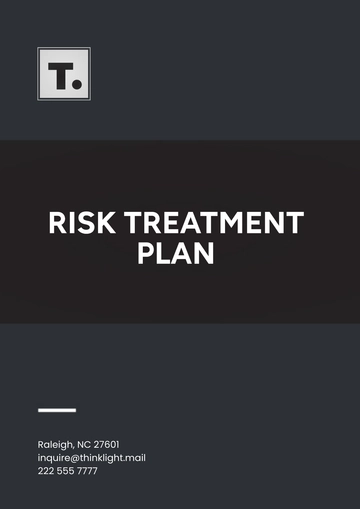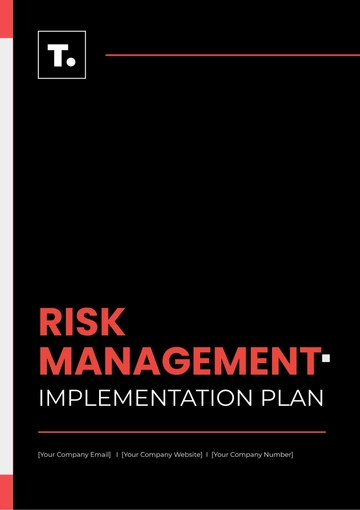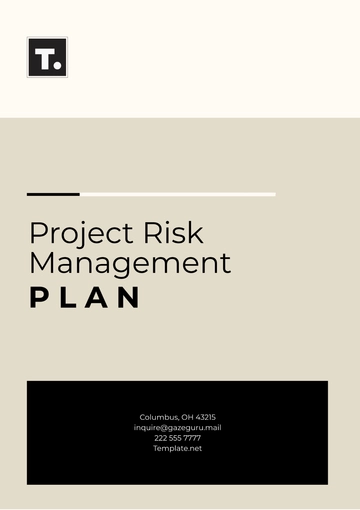Free Banking Compliance Plan Layout

Date: [Date]
Prepared By: [Your Name]
I. Executive Summary
Purpose: Overview of the plan's objectives, goals, and importance in ensuring compliance within the banking industry.
[Insert Purpose of Compliance Plan]Scope: The areas and regulations the compliance plan covers (e.g., anti-money laundering, consumer protection, fraud prevention, etc.).
[Insert Scope of Compliance Plan]Key Goals: To reduce risks, maintain regulatory compliance, and uphold industry standards.
[Insert Key Goals of Compliance Plan]
II. Compliance Objectives
Regulatory Compliance: Ensuring adherence to all applicable banking laws, regulations, and guidelines.
[Insert Regulatory Compliance Goals]Risk Management: Identifying and managing potential compliance risks within the bank.
[Insert Risk Management Strategy]Internal Controls: Strengthening internal policies and procedures to mitigate non-compliance.
[Insert Internal Control Procedures]Training and Awareness: Providing training for employees on banking regulations, ethics, and compliance standards.
[Insert Training Plan and Objectives]
III. Legal and Regulatory Framework
Relevant Regulations:
Dodd-Frank Act
Bank Secrecy Act (BSA)
Anti-Money Laundering (AML)
Know Your Customer (KYC) requirements
Consumer Financial Protection Bureau (CFPB) guidelines
Local and international regulations (e.g., GDPR, FATF standards)
[Insert Relevant Laws and Regulations Specific to Your Bank]
Regulatory Bodies:
Federal Reserve
Office of the Comptroller of the Currency (OCC)
Securities and Exchange Commission (SEC)
State Regulatory Authorities
[Insert Relevant Regulatory Bodies Specific to Your Location]
IV. Compliance Risk Assessment
Risk Identification: Identifying the risks related to non-compliance in various departments (e.g., lending, payments, investments).
[Insert Identified Risks]Risk Analysis: Evaluating the severity of each risk and its potential impact on the bank.
[Insert Risk Analysis Methodology]Risk Mitigation: Creating action plans to minimize the likelihood of non-compliance occurrences.
[Insert Mitigation Strategies]Monitoring: Ongoing risk monitoring through audits, inspections, and reports.
[Insert Monitoring Tools and Processes]
V. Policies and Procedures
Compliance Policies:
KYC and AML Policies
Customer Privacy and Data Protection Policies
Transaction Monitoring Policies
Recordkeeping and Reporting Guidelines
[Insert Specific Compliance Policies]
Internal Procedures:
Procedures for reporting compliance issues
Protocol for handling audits and inspections
Standard operating procedures (SOPs) for compliance-related tasks
[Insert Detailed Internal Procedures]
VI. Compliance Roles and Responsibilities
Compliance Officer: The primary responsible individual for managing compliance activities and ensuring adherence to regulations.
[Insert Name/Role of Compliance Officer]Internal Audit Team: Responsible for conducting compliance audits and identifying areas of improvement.
[Insert Team Members and Responsibilities]Management and Staff: Ensure all employees understand compliance expectations and contribute to maintaining a compliant culture.
[Insert Roles of Management and Staff]
VII. Compliance Training and Education
Employee Training Programs:
Regular training sessions on key compliance areas (e.g., AML, KYC, consumer protection).
Online compliance courses and assessments.
[Insert Training Schedule and Topics]
Ongoing Education:
Keeping staff updated on changes in regulations.
External training opportunities (e.g., webinars, conferences).
[Insert Ongoing Education Plan]
VIII. Monitoring and Reporting
Monitoring Tools: Tools used to monitor compliance (e.g., automated monitoring systems for transactions, internal audit systems).
[Insert Monitoring Tools Used]Reporting Mechanisms:
Reporting non-compliance incidents.
Regular reports to senior management and regulatory bodies.
Periodic internal reviews of compliance performance.
[Insert Reporting Structure and Process]
IX. Corrective Actions and Continuous Improvement
Non-Compliance Response:
Procedures for identifying, investigating, and addressing instances of non-compliance.
Corrective action plans for improving compliance processes.
[Insert Corrective Actions and Plans]
Continuous Improvement:
Regular reviews of the compliance program.
Feedback loop to improve policies and procedures based on lessons learned.
[Insert Continuous Improvement Strategy]
X. Documentation and Record Keeping
Record Retention Policy: Ensuring compliance records are stored in accordance with legal and regulatory requirements.
[Insert Record Retention Policies]Documentation of Compliance Activities: All activities related to compliance must be documented, including audits, training, and risk assessments.
[Insert Documentation Guidelines]Compliance Reports: Keeping track of submitted reports to regulatory bodies and any associated documentation.
[Insert Report Tracking Process]
XI. Conclusion
Summary: Recap of the importance of compliance in the banking sector and the bank’s commitment to maintaining a compliant environment.
[Insert Conclusion or Closing Remarks]Next Steps: Outline the next steps for the ongoing development of the compliance program.
[Insert Next Steps]
- 100% Customizable, free editor
- Access 1 Million+ Templates, photo’s & graphics
- Download or share as a template
- Click and replace photos, graphics, text, backgrounds
- Resize, crop, AI write & more
- Access advanced editor
Ensure your banking operations meet industry standards with the Banking Compliance Plan Layout Template offered by Template.net. This fully customizable, downloadable, and printable template provides a professional layout for seamless compliance planning. Effortlessly editable in our AI Editor Tool, it guarantees a tailored solution to align with regulatory requirements. Simplify compliance management today!
You may also like
- Finance Plan
- Construction Plan
- Sales Plan
- Development Plan
- Career Plan
- Budget Plan
- HR Plan
- Education Plan
- Transition Plan
- Work Plan
- Training Plan
- Communication Plan
- Operation Plan
- Health And Safety Plan
- Strategy Plan
- Professional Development Plan
- Advertising Plan
- Risk Management Plan
- Restaurant Plan
- School Plan
- Nursing Home Patient Care Plan
- Nursing Care Plan
- Plan Event
- Startup Plan
- Social Media Plan
- Staffing Plan
- Annual Plan
- Content Plan
- Payment Plan
- Implementation Plan
- Hotel Plan
- Workout Plan
- Accounting Plan
- Campaign Plan
- Essay Plan
- 30 60 90 Day Plan
- Research Plan
- Recruitment Plan
- 90 Day Plan
- Quarterly Plan
- Emergency Plan
- 5 Year Plan
- Gym Plan
- Personal Plan
- IT and Software Plan
- Treatment Plan
- Real Estate Plan
- Law Firm Plan
- Healthcare Plan
- Improvement Plan
- Media Plan
- 5 Year Business Plan
- Learning Plan
- Marketing Campaign Plan
- Travel Agency Plan
- Cleaning Services Plan
- Interior Design Plan
- Performance Plan
- PR Plan
- Birth Plan
- Life Plan
- SEO Plan
- Disaster Recovery Plan
- Continuity Plan
- Launch Plan
- Legal Plan
- Behavior Plan
- Performance Improvement Plan
- Salon Plan
- Security Plan
- Security Management Plan
- Employee Development Plan
- Quality Plan
- Service Improvement Plan
- Growth Plan
- Incident Response Plan
- Basketball Plan
- Emergency Action Plan
- Product Launch Plan
- Spa Plan
- Employee Training Plan
- Data Analysis Plan
- Employee Action Plan
- Territory Plan
- Audit Plan
- Classroom Plan
- Activity Plan
- Parenting Plan
- Care Plan
- Project Execution Plan
- Exercise Plan
- Internship Plan
- Software Development Plan
- Continuous Improvement Plan
- Leave Plan
- 90 Day Sales Plan
- Advertising Agency Plan
- Employee Transition Plan
- Smart Action Plan
- Workplace Safety Plan
- Behavior Change Plan
- Contingency Plan
- Continuity of Operations Plan
- Health Plan
- Quality Control Plan
- Self Plan
- Sports Development Plan
- Change Management Plan
- Ecommerce Plan
- Personal Financial Plan
- Process Improvement Plan
- 30-60-90 Day Sales Plan
- Crisis Management Plan
- Engagement Plan
- Execution Plan
- Pandemic Plan
- Quality Assurance Plan
- Service Continuity Plan
- Agile Project Plan
- Fundraising Plan
- Job Transition Plan
- Asset Maintenance Plan
- Maintenance Plan
- Software Test Plan
- Staff Training and Development Plan
- 3 Year Plan
- Brand Activation Plan
- Release Plan
- Resource Plan
- Risk Mitigation Plan
- Teacher Plan
- 30 60 90 Day Plan for New Manager
- Food Safety Plan
- Food Truck Plan
- Hiring Plan
- Quality Management Plan
- Wellness Plan
- Behavior Intervention Plan
- Bonus Plan
- Investment Plan
- Maternity Leave Plan
- Pandemic Response Plan
- Succession Planning
- Coaching Plan
- Configuration Management Plan
- Remote Work Plan
- Self Care Plan
- Teaching Plan
- 100-Day Plan
- HACCP Plan
- Student Plan
- Sustainability Plan
- 30 60 90 Day Plan for Interview
- Access Plan
- Site Specific Safety Plan





























